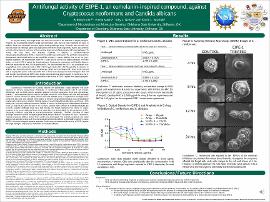| dc.contributor.advisor | Wozniak, Karen L. | |
| dc.contributor.author | Conn, Brittney | |
| dc.contributor.author | Maritz, Emma | |
| dc.contributor.author | Nelson, Toby L. | |
| dc.contributor.other | Wentz Research Scholars | |
| dc.date.accessioned | 2021-05-25T18:58:17Z | |
| dc.date.available | 2021-05-25T18:58:17Z | |
| dc.date.issued | 2021-04 | |
| dc.identifier | oksd_Wentz_2021_conn | |
| dc.identifier.citation | Conn, B., Maritz, E., Nelson, T. L., & Wozniak, K. L. (2021, April). Antifungal activity of EIPE-1, an eumelanin compound, against Cryptococcus neoformans and Candida albicans. Poster session presented at the Oklahoma State University Wentz Research Scholars Symposium, Stillwater, OK. | |
| dc.identifier.uri | https://hdl.handle.net/11244/329860 | |
| dc.description.abstract | In the past century, anti-fungal drugs have had much success in the treatment of fungal pathogens. However, due to similarities between fungal and mammalian cells, many of these treatments are toxic. In addition, fungi have developed resistance against existing antifungal drugs. Currently, there are only four separate classes of antifungal agents that target plasma membrane sterols (ergosterol), nucleic acid synthesis and cell wall constituents, and some of these existing drugs are not effective against all fungal pathogens. To combat this issue along with antibiotic resistance in bacteria, a eumelanin-inspired indoylenepheyleneethynylene, EIPE-1, derived from vanillin was synthesized. The synthetic compound has demonstrated antimicrobial effects on the methicillin resistant S. aureus (MSRA), but not on the gram-negative organisms. We hypothesized that EIPE-1 could also be used to kill fungal pathogens. For these studies, we tested EIPE-1 against the fungal pathogens Cryptococcus neoformans and Candida albicans, which are responsible for over 200,000 yearly deaths. Our results showed that EIPE-1 has considerable antifungal effects on C. neoformans with a MIC of 1.749 ug/ml and a MIC of 2.705 ug/ml for C. albicans. In addition, we conducted scanning electron microscopy (SEM) and transmission EM (TEM) on the exposed cells at varying time points. Cells exposed for four or more hours displayed structural changes to their cell wall. Overall, we conclude that EIPE-1 does display potent anti-fungal activity against C. neoformans and C. albicans. Future studies will examine the mechanism of the activity of EIPE-1 against these fungal pathogens. | |
| dc.description.sponsorship | Lew Wentz Foundation | |
| dc.format | application/pdf | |
| dc.language | en_US | |
| dc.publisher | Oklahoma State University | |
| dc.rights | In the Oklahoma State University Library's institutional repository this paper is made available through the open access principles and the terms of agreement/consent between the author(s) and the publisher. The permission policy on the use, reproduction or distribution of the article falls under fair use for educational, scholarship, and research purposes. Contact Digital Resources and Discovery Services at lib-dls@okstate.edu or 405-744-9161 for further information. | |
| dc.title | Antifungal activity of EIPE-1, an eumelanin compound, against Cryptococcus neoformans and Candida albicans | |
| osu.filename | oksd_Wentz_2021_conn.pdf | |
| dc.description.department | Microbiology and Molecular Genetics | |
| dc.description.department | Chemistry | |
| dc.type.genre | Presentation | |
| dc.type.material | Text | |
| dc.subject.keywords | anti-fungal | |
| dc.subject.keywords | fungal | |
| dc.subject.keywords | cryptococcus neoformans | |
| dc.subject.keywords | candida albicans | |
